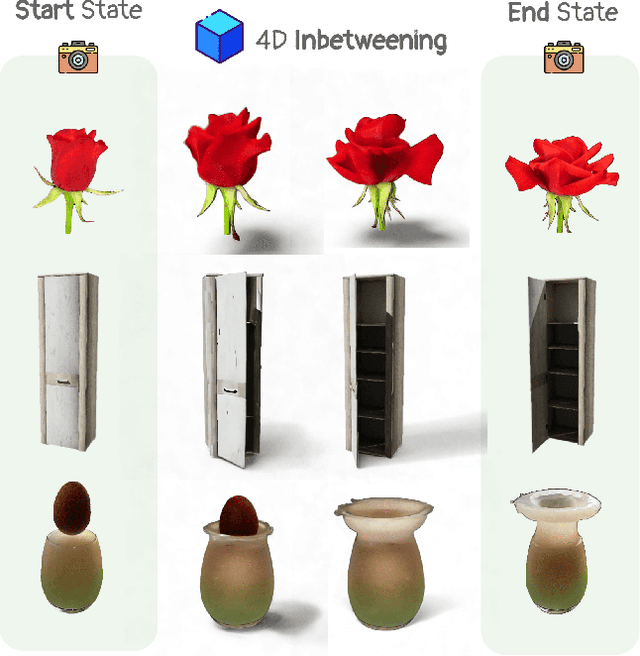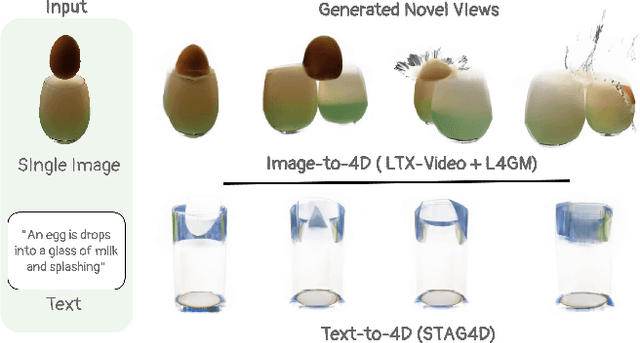Daniel Cohen-Or
Visual Diffusion Models are Geometric Solvers
Oct 24, 2025Abstract:In this paper we show that visual diffusion models can serve as effective geometric solvers: they can directly reason about geometric problems by working in pixel space. We first demonstrate this on the Inscribed Square Problem, a long-standing problem in geometry that asks whether every Jordan curve contains four points forming a square. We then extend the approach to two other well-known hard geometric problems: the Steiner Tree Problem and the Simple Polygon Problem. Our method treats each problem instance as an image and trains a standard visual diffusion model that transforms Gaussian noise into an image representing a valid approximate solution that closely matches the exact one. The model learns to transform noisy geometric structures into correct configurations, effectively recasting geometric reasoning as image generation. Unlike prior work that necessitates specialized architectures and domain-specific adaptations when applying diffusion to parametric geometric representations, we employ a standard visual diffusion model that operates on the visual representation of the problem. This simplicity highlights a surprising bridge between generative modeling and geometric problem solving. Beyond the specific problems studied here, our results point toward a broader paradigm: operating in image space provides a general and practical framework for approximating notoriously hard problems, and opens the door to tackling a far wider class of challenging geometric tasks.
SAEdit: Token-level control for continuous image editing via Sparse AutoEncoder
Oct 06, 2025Abstract:Large-scale text-to-image diffusion models have become the backbone of modern image editing, yet text prompts alone do not offer adequate control over the editing process. Two properties are especially desirable: disentanglement, where changing one attribute does not unintentionally alter others, and continuous control, where the strength of an edit can be smoothly adjusted. We introduce a method for disentangled and continuous editing through token-level manipulation of text embeddings. The edits are applied by manipulating the embeddings along carefully chosen directions, which control the strength of the target attribute. To identify such directions, we employ a Sparse Autoencoder (SAE), whose sparse latent space exposes semantically isolated dimensions. Our method operates directly on text embeddings without modifying the diffusion process, making it model agnostic and broadly applicable to various image synthesis backbones. Experiments show that it enables intuitive and efficient manipulations with continuous control across diverse attributes and domains.
Zero-Shot Dynamic Concept Personalization with Grid-Based LoRA
Jul 23, 2025Abstract:Recent advances in text-to-video generation have enabled high-quality synthesis from text and image prompts. While the personalization of dynamic concepts, which capture subject-specific appearance and motion from a single video, is now feasible, most existing methods require per-instance fine-tuning, limiting scalability. We introduce a fully zero-shot framework for dynamic concept personalization in text-to-video models. Our method leverages structured 2x2 video grids that spatially organize input and output pairs, enabling the training of lightweight Grid-LoRA adapters for editing and composition within these grids. At inference, a dedicated Grid Fill module completes partially observed layouts, producing temporally coherent and identity preserving outputs. Once trained, the entire system operates in a single forward pass, generalizing to previously unseen dynamic concepts without any test-time optimization. Extensive experiments demonstrate high-quality and consistent results across a wide range of subjects beyond trained concepts and editing scenarios.
EditP23: 3D Editing via Propagation of Image Prompts to Multi-View
Jun 25, 2025Abstract:We present EditP23, a method for mask-free 3D editing that propagates 2D image edits to multi-view representations in a 3D-consistent manner. In contrast to traditional approaches that rely on text-based prompting or explicit spatial masks, EditP23 enables intuitive edits by conditioning on a pair of images: an original view and its user-edited counterpart. These image prompts are used to guide an edit-aware flow in the latent space of a pre-trained multi-view diffusion model, allowing the edit to be coherently propagated across views. Our method operates in a feed-forward manner, without optimization, and preserves the identity of the original object, in both structure and appearance. We demonstrate its effectiveness across a range of object categories and editing scenarios, achieving high fidelity to the source while requiring no manual masks.
Unblocking Fine-Grained Evaluation of Detailed Captions: An Explaining AutoRater and Critic-and-Revise Pipeline
Jun 09, 2025Abstract:Large Vision-Language Models (VLMs) now generate highly detailed, paragraphlength image captions, yet evaluating their factual accuracy remains challenging. Current methods often miss fine-grained errors, being designed for shorter texts or lacking datasets with verified inaccuracies. We introduce DOCCI-Critique, a benchmark with 1,400 VLM-generated paragraph captions (100 images, 14 VLMs) featuring over 10,216 sentence-level human annotations of factual correctness and explanatory rationales for errors, all within paragraph context. Building on this, we develop VNLI-Critique, a model for automated sentence-level factuality classification and critique generation. We highlight three key applications: (1) VNLI-Critique demonstrates robust generalization, validated by state-of-the-art performance on the M-HalDetect benchmark and strong results in CHOCOLATE claim verification. (2) The VNLI-Critique driven AutoRater for DOCCI-Critique provides reliable VLM rankings, showing excellent alignment with human factuality judgments (e.g., 0.98 Spearman). (3) An innovative Critic-and-Revise pipeline, where critiques from VNLI-Critique guide LLM-based corrections, achieves substantial improvements in caption factuality (e.g., a 46% gain on DetailCaps-4870). Our work offers a crucial benchmark alongside practical tools, designed to significantly elevate the standards for fine-grained evaluation and foster the improvement of VLM image understanding. Project page: https://google.github.io/unblocking-detail-caption
Be Decisive: Noise-Induced Layouts for Multi-Subject Generation
May 27, 2025Abstract:Generating multiple distinct subjects remains a challenge for existing text-to-image diffusion models. Complex prompts often lead to subject leakage, causing inaccuracies in quantities, attributes, and visual features. Preventing leakage among subjects necessitates knowledge of each subject's spatial location. Recent methods provide these spatial locations via an external layout control. However, enforcing such a prescribed layout often conflicts with the innate layout dictated by the sampled initial noise, leading to misalignment with the model's prior. In this work, we introduce a new approach that predicts a spatial layout aligned with the prompt, derived from the initial noise, and refines it throughout the denoising process. By relying on this noise-induced layout, we avoid conflicts with externally imposed layouts and better preserve the model's prior. Our method employs a small neural network to predict and refine the evolving noise-induced layout at each denoising step, ensuring clear boundaries between subjects while maintaining consistency. Experimental results show that this noise-aligned strategy achieves improved text-image alignment and more stable multi-subject generation compared to existing layout-guided techniques, while preserving the rich diversity of the model's original distribution.
HoLa: B-Rep Generation using a Holistic Latent Representation
Apr 22, 2025Abstract:We introduce a novel representation for learning and generating Computer-Aided Design (CAD) models in the form of $\textit{boundary representations}$ (B-Reps). Our representation unifies the continuous geometric properties of B-Rep primitives in different orders (e.g., surfaces and curves) and their discrete topological relations in a $\textit{holistic latent}$ (HoLa) space. This is based on the simple observation that the topological connection between two surfaces is intrinsically tied to the geometry of their intersecting curve. Such a prior allows us to reformulate topology learning in B-Reps as a geometric reconstruction problem in Euclidean space. Specifically, we eliminate the presence of curves, vertices, and all the topological connections in the latent space by learning to distinguish and derive curve geometries from a pair of surface primitives via a neural intersection network. To this end, our holistic latent space is only defined on surfaces but encodes a full B-Rep model, including the geometry of surfaces, curves, vertices, and their topological relations. Our compact and holistic latent space facilitates the design of a first diffusion-based generator to take on a large variety of inputs including point clouds, single/multi-view images, 2D sketches, and text prompts. Our method significantly reduces ambiguities, redundancies, and incoherences among the generated B-Rep primitives, as well as training complexities inherent in prior multi-step B-Rep learning pipelines, while achieving greatly improved validity rate over current state of the art: 82% vs. $\approx$50%.
In-2-4D: Inbetweening from Two Single-View Images to 4D Generation
Apr 11, 2025



Abstract:We propose a new problem, In-2-4D, for generative 4D (i.e., 3D + motion) inbetweening from a minimalistic input setting: two single-view images capturing an object in two distinct motion states. Given two images representing the start and end states of an object in motion, our goal is to generate and reconstruct the motion in 4D. We utilize a video interpolation model to predict the motion, but large frame-to-frame motions can lead to ambiguous interpretations. To overcome this, we employ a hierarchical approach to identify keyframes that are visually close to the input states and show significant motion, then generate smooth fragments between them. For each fragment, we construct the 3D representation of the keyframe using Gaussian Splatting. The temporal frames within the fragment guide the motion, enabling their transformation into dynamic Gaussians through a deformation field. To improve temporal consistency and refine 3D motion, we expand the self-attention of multi-view diffusion across timesteps and apply rigid transformation regularization. Finally, we merge the independently generated 3D motion segments by interpolating boundary deformation fields and optimizing them to align with the guiding video, ensuring smooth and flicker-free transitions. Through extensive qualitative and quantitiave experiments as well as a user study, we show the effectiveness of our method and its components. The project page is available at https://in-2-4d.github.io/
TriTex: Learning Texture from a Single Mesh via Triplane Semantic Features
Mar 20, 2025Abstract:As 3D content creation continues to grow, transferring semantic textures between 3D meshes remains a significant challenge in computer graphics. While recent methods leverage text-to-image diffusion models for texturing, they often struggle to preserve the appearance of the source texture during texture transfer. We present \ourmethod, a novel approach that learns a volumetric texture field from a single textured mesh by mapping semantic features to surface colors. Using an efficient triplane-based architecture, our method enables semantic-aware texture transfer to a novel target mesh. Despite training on just one example, it generalizes effectively to diverse shapes within the same category. Extensive evaluation on our newly created benchmark dataset shows that \ourmethod{} achieves superior texture transfer quality and fast inference times compared to existing methods. Our approach advances single-example texture transfer, providing a practical solution for maintaining visual coherence across related 3D models in applications like game development and simulation.
Piece it Together: Part-Based Concepting with IP-Priors
Mar 13, 2025Abstract:Advanced generative models excel at synthesizing images but often rely on text-based conditioning. Visual designers, however, often work beyond language, directly drawing inspiration from existing visual elements. In many cases, these elements represent only fragments of a potential concept-such as an uniquely structured wing, or a specific hairstyle-serving as inspiration for the artist to explore how they can come together creatively into a coherent whole. Recognizing this need, we introduce a generative framework that seamlessly integrates a partial set of user-provided visual components into a coherent composition while simultaneously sampling the missing parts needed to generate a plausible and complete concept. Our approach builds on a strong and underexplored representation space, extracted from IP-Adapter+, on which we train IP-Prior, a lightweight flow-matching model that synthesizes coherent compositions based on domain-specific priors, enabling diverse and context-aware generations. Additionally, we present a LoRA-based fine-tuning strategy that significantly improves prompt adherence in IP-Adapter+ for a given task, addressing its common trade-off between reconstruction quality and prompt adherence.
 Add to Chrome
Add to Chrome Add to Firefox
Add to Firefox Add to Edge
Add to Edge